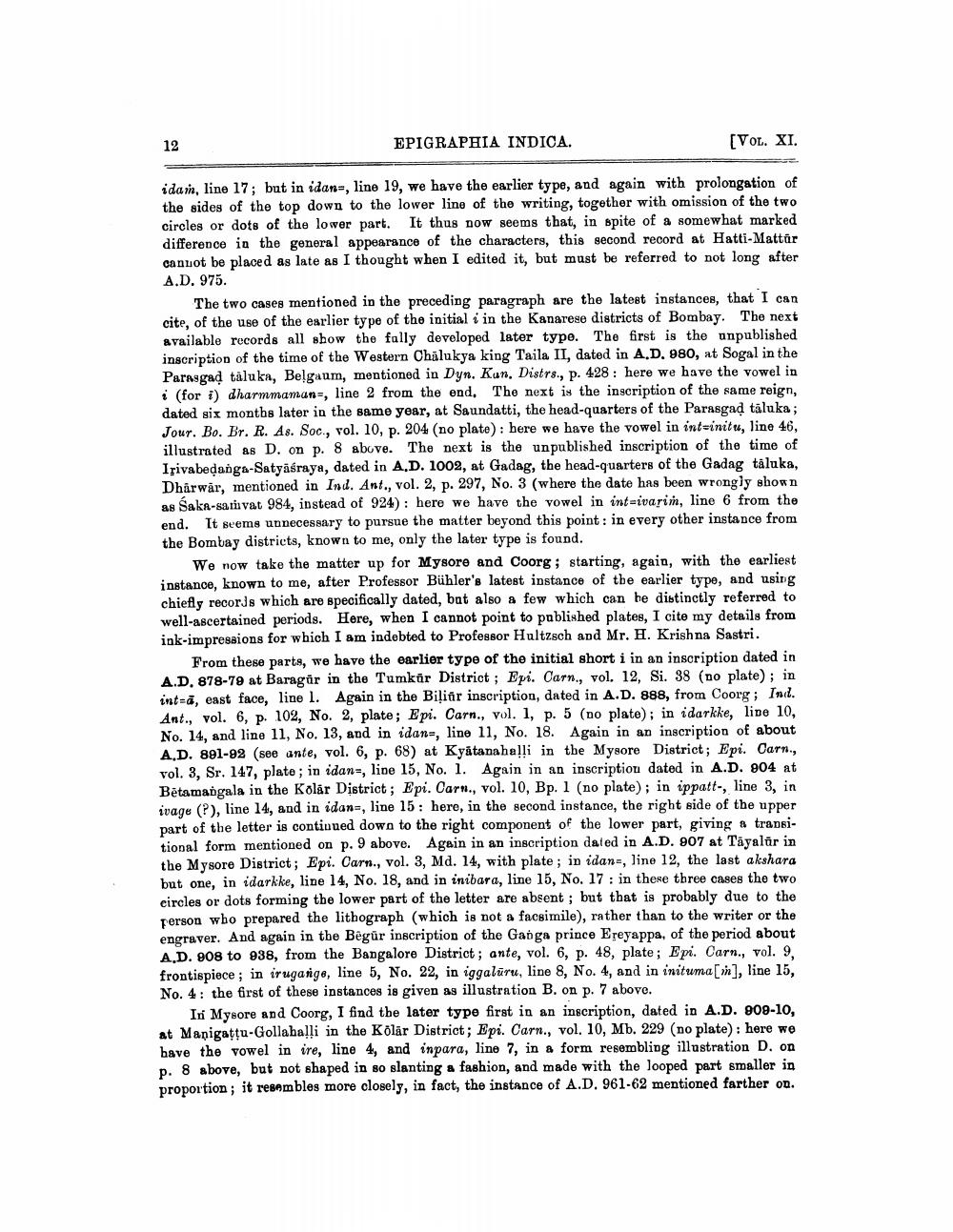________________
12
EPIGRAPHIA INDICA.
[VOL. XI.
idam, line 17; but in idan-, line 19, we have the earlier type, and again with prolongation of the sides of the top down to the lower line of the writing, together with omission of the two circles or dots of the lower part. It thus now seems that, in spite of a somewhat marked difference in the general appearance of the characters, this second record at Hatti-Mattor cannot be placed as late as I thought when I edited it, but must be referred to not long after A.D. 975.
The two cases mentioned in the preceding paragraph are the latest instances, that I can cite, of the use of the earlier type of the initial i in the Kanarese districts of Bombay. The next available records all show the fally developed later type. The first is the unpublished inscription of the time of the Western Chūlukya king Taila II, dated in A.D. 980, at Sogal in the Parasgad taluka, Belgaum, mentioned in Dyn. Kun. Distrs., p. 428: here we have the vowel in i (for i) dharmmamans, line 2 from the end. The next is the inscription of the same reign, dated six months later in the same year, at Saundatti, the head-quarters of the Parasgad tāluka; Jour. Bo. Br. R. As. Soc., vol. 10, p. 204 (no plate): here we have the vowel in int=initu, line 46, illustrated as D. on p. 8 above. The next is the unpublished inscription of the time of Isivabedanga-Satyäśraya, dated in A.D. 1002, at Gadag, the head-quarters of the Gadag tāluka, Dharwar, mentioned in Ind. Ant., vol. 2, p. 297, No. 3 (where the date has been wrongly shown as Saka-sativat 984, instead of 924): here we have the vowel in int=ivarin, line 6 from the end. It seems unnecessary to pursue the matter beyond this point: in every other instance from the Bombay districts, known to me, only the later type is found.
We now take the matter up for Mysore and Coorg ; starting, again, with the earliest instance, known to me, after Professor Bühler's latest instance of the earlier type, and using chiefly records which are specifically dated, but also a few which can be distinctly referred to well-ascertained periods. Here, when I cannot point to published plates, I cite my details from ink-impressions for which I am indebted to Professor Hultzsch and Mr. H. Krishna Sastri.
From these parts, we have the earlier type of the initial short i in an inscription dated in A.D. 878-79 at Baragar in the Tumkör District ; Epi. Carn., vol. 12, Si. 38 (no plate); in int-ă, east face, line 1. Again in the Biļiar inscription, dated in A.D. 888, from Coorg; Ind. Ant., vol. 6, p. 102, No. 2, plate; Epi. Carn., vol. 1, p. 5 (no plate); in idarkke, line 10, No. 14, and line 11, No. 13, and in idans, line 11, No. 18. Again in an inscription of about A.D. 891-92 (see ante, vol. 6, p. 68) at Kyátanahalli in the Mysore District; Epi. Carn., vol. 3, Sr. 147, plate; in idans, line 15, No. 1. Again in an inscriptiou dated in A.D. 904 at Bētamangala in the Kolár District; Epi. Carn., vol. 10, Bp. 1 (no plate); in ippatt., line 3, in ivage (?), line 14, and in idana, line 15: here, in the second instance, the right side of the upper part of the letter is continued down to the right component of the lower part, giving & transitional form mentioned on p. 9 above. Again in an inscription dated in A.D. 907 at Täyalär in the Mysore District; Epi. Carn., vol. 3, Md. 14, with plate; in idan-, line 12, the last akshara but one, in idarkke, line 14, No. 18, and in inibara, line 15, No. 17 : in these three cases the two circles or dots forming the lower part of the letter are absent; but that is probably due to the person who prepared the lithograph (which is not a facsimile), rather than to the writer or the engraver. And again in the Begür inscription of the Ganga prince Ereyappa, of the period about A.D. 908 to 038, from the Bangalore District; ante, vol. 6, p. 48, plate; Epi. Carn., vol. 9, frontispiece; in irugange, line 5, No. 22, in iggaluru, line 8, No. 4, and in inituma[m], line 15, No. 4: the first of these instances is given as illustration B. on p. 7 above.
Iri Mysore and Coorg, I find the later type first in an inscription, dated in A.D. 909-10, at Manigatsu-Gollahalli in the Kõlar District; Epi. Carn., vol. 10, Mb. 229 (no plate): here we have the vowel in ire, line 4, and inpara, line 7, in a form resembling illustration D. on p. 8 above, but not shaped in so slanting a fashion, and made with the looped part smaller in proportion; it resembles more closely, in fact, the instance of A.D. 961-62 mentioned farther on.




